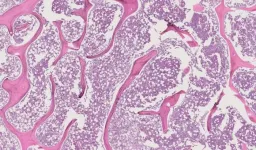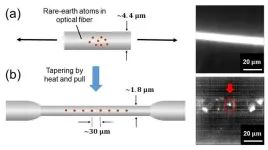(Press-News.org) PITTSBURGH – November 2, 2023 – A vaginal film designed to slowly dissolve over the course of 30 days is being put to the test for the first time in a study launched this week that aims to determine its feasibility and acceptability as a potential HIV prevention method for women.
The study, which is being conducted in the United States and Africa by MATRIX, a United States Agency for International Development (USAID)-funded project focused on the early research and development of innovative HIV prevention products for women, will help inform the final design of a monthly film containing the antiretroviral (ARV) drug dapivirine. The monthly dapivirine film is one of nine products being developed under MATRIX, which also includes a dual-purpose monthly film containing both dapivirine and a hormonal contraceptive to prevent pregnancy.
Similar to thin breath mint strips that dissolve in the mouth, vaginal films are products designed to dissolve after being inserted into the vagina. Previous studies exploring the use of vaginal films as a drug delivery method for HIV prevention have been of quick-dissolve films or films designed to dissolve within a week.
In the new study, known as MATRIX-002, researchers are assessing the acceptability, usability and safety of two prototype monthly vaginal films that contain no active drug. In this way, they will be able to learn what refinements may be needed in the film’s design, including to its shape, before conducting a first-in-human study of the monthly dapivirine film.
MATRIX-002 will enroll 100 women, as well as 30 sexual partners, at five sites in Kenya, South Africa, Zimbabwe and the United States. Enrollment of the first participants took place at the US site, based at the University of Pittsburgh and Magee-Womens Research Institute (MWRI), which is also where the monthly dapivirine vaginal film products are being developed.
“By conducting a study of placebo films with no active drug, we will be able to answer fundamentally important questions. For instance, are women, especially African women, comfortable with the idea of using a vaginal film that takes 30 days to dissolve? What kind of support and counseling will they need to use it properly?,” noted Nyaradzo Mgodi, MBChB, MMed, MATRIX-002 protocol co-chair and investigator of record at the Harare Health and Research Consortium (HHRC) Zengeza clinical research site (CRS) in Zimbabwe, one of the five sites conducting the study.
“We are fully aware of the urgent need for more HIV prevention methods for women, but we also don’t want to rush into study of a new product with design features that may not be to the liking of women and could therefore impact product use. Something as simple as the shape of the film, or how it feels to the touch, are important considerations that are best resolved as early in the process as possible,” added Alexandra Minnis, PhD, a behavioral scientist from RTI International, Berkeley, Calif., who is protocol co-chair.
A key focus of MATRIX is being responsive to end-user and stakeholder feedback during the earliest stages of product development to inform decisions about product design and improve the odds for success of the products in its portfolio, which is why a study like MATRIX-002 is being conducted and why it is designed the way it is – evaluating two prototype vaginal films, both of which are of similar size (2” x 2”) but differ in their shape, one having straight corners and the other rounded corners. If not for the feedback that came out of stakeholder consultations convened in Kenya, South Africa, and Zimbabwe in 2022, during which prototype films were passed around, the MATRIX-002 study would have instead concentrated on the original square design. But upon learning that advocates and young women, in particular, disliked the straight corners of the film, researchers modified its shape by rounding the corners, recognizing also that this modification would result in a slightly higher product cost. While cost is an important factor to consider, so too are the preferences of women who will actually use the film, insight into which the MATRIX-002 study will provide.
As such, women who enroll in the study will be randomly assigned to use one of the two placebo films – either a film with straight corners or one with rounded corners. Participants will use their assigned film twice, for one month each. During the first month of film use, women are to refrain from vaginal sex and vaginal product use. During the second month, when a new film will be used, there will be no such restrictions. Women will insert the films themselves in the clinic with study staff providing guidance and instructions. As part of the study, participants will be asked questions about their experiences, including likes and dislikes, with film use, and up to 35 participants will also be asked to participate in an in-depth interview so that the study can gain deeper insight into women’s experience with and views about the film. In-depth interviews will also be conducted with approximately 30 sexual partners.
The study is expected to be underway at all five clinical research sites (CRS) by early 2024, which in addition to the University of Pittsburgh/MWRI and the HHRC CRS in Zimbabwe, includes the Kenya Medical Research Institute (KEMRI) Centre for Clinical Research Thika CRS and two sites in South Africa: the Aurum Institute Klerksdorp CRS and the Wits Reproductive Health and HIV Institute (Wits RHI) CRS in Johannesburg.
Follow-up of all participants is anticipated to be completed in July or August 2024, with study results anticipated by the end of the year (2024). MATRIX would then expect to be conducting the first-in-human study of the monthly dapivirine film in 2025.
Dapivirine is already known to be safe and effective for preventing HIV when formulated as a monthly vaginal ring, and in fact, the dapivirine vaginal ring has been recommended by the World Health Organization as an additional HIV prevention option for women and approved for use in several African countries, including Kenya, South Africa and Zimbabwe. The monthly film containing dapivirine is designed so that when it is placed inside the vagina and comes in contact with vaginal fluid, it will slowly begin to dissolve, and in doing so, release dapivirine. The drug would continue to be slowly released over the course of a month until the film completely dissolves and all of the drug has been delivered in the vagina. This means that there would be nothing to remove or discard before inserting a new film for another month of protection.
Development of both the monthly dapivirine film and the monthly dual-purpose dapivirine and contraceptive film is being conducted by a team of researchers at the University of Pittsburgh and MWRI under the direction of Lisa Rohan, PhD, professor of pharmaceutical sciences, University of Pittsburgh School of Pharmacy, and professor of obstetrics, gynecology & reproductive sciences, University of Pittsburgh School of Medicine. Both products are being developed in collaboration with the Population Council, a global nonprofit research organization, which acquired the dapivirine product pipeline from the International Partnership for Microbicides.
According to UNAIDS, women and girls accounted for 63 percent of all new HIV infections in sub-Saharan Africa in 2022, versus 46 percent globally. In much of Africa, daily oral PrEP (pre-exposure prophylaxis), which requires taking an ARV tablet every day, is the only biomedical prevention method available. Daily pill-taking has been especially challenging for adolescent girls and young women. Despite the dapivirine ring and cabotegravir long-acting injectable (CAB-LA) both being recommended by WHO and approved in several African countries, neither method is yet widely available. Even so, women have different preferences and needs, and at different times in their lives, which is why additional options are needed.
MATRIX is a five-year program funded by USAID in 2021 that aims to expedite the research and development of HIV prevention products for women – including products designed to protect against both HIV and pregnancy – that in addition to being safe and effective, will be acceptable, affordable, scalable and deliverable in the settings where they are needed most. MATRIX activities are focused on the early research and development of products, which involves both pre-clinical research and the first clinical trials of products. Through its North-South partnerships, MATRIX also aims to strengthen the capacity of African investigators to facilitate full and sustainable ownership of this work into the future. MATRIX is being implemented by Magee-Womens Research Institute (MWRI) in collaboration with partner organizations based in Kenya, South Africa, the United States and Zimbabwe. Leading the project is Sharon Hillier, Ph.D., of MWRI and the University of Pittsburgh School of Medicine, with Thesla Palanee-Phillips, Ph.D., from the Wits RHI and University of Witwatersrand, South Africa, serving as deputy director.
# # #
To learn about MATRIX go to www.matrix4prevention.org. Click here to read a QA about the dapivirine film and MATRIX-002 study. Additional information about MATRIX-002 can also be found at www.matrix4prevention.org/activity-hubs/clinical-trials/matrix-002.
MATRIX was established through the generous support of the American people through the U.S. President’s Emergency Plan for AIDS Relief (PEPFAR) and the U.S. Agency for International Development (USAID).
(United States Agency for International Development (USAID) Cooperative Agreement Number 7200AA22CA00002)
The content and views in this document are those of MATRIX and its partners and do not necessarily reflect the views of PEPFAR, USAID or the U.S. Government.
END
Researchers launch first study of a vaginal film that dissolves in 30 days to assess its acceptability as a potential HIV prevention method for women
Study taking place in US and sub-Saharan Africa will also help inform final design of a monthly film containing dapivirine
2023-11-02
ELSE PRESS RELEASES FROM THIS DATE:
Scientists designed the deployment of three-body chain-type tethered satellites in low-eccentricity orbits using only tether
2023-11-02
Recently, the tethered satellite system (TSS) has been used in Earth observations, space interferometry and other space missions, due to potential merits of TSS. The tethered TSAR (tomographic synthetic aperture radar) system is a group of tethered SAR satellites that can be rapidly deployed and provide a stable baseline for 3-dimensional topographic mapping and moving target detection. Successful deployment is critical for TSAR tethered system. Several control methods, including length, length rate, tension, and thrust-aided control, have been proposed over the years. Among them, adjusting tension is a viable yet challenging approach due to tether's strong nonlinearity and ...
Drexel University study projects more water shortfalls in Schuylkill Watershed in next 20 years due to climate change
2023-11-02
Research out of Drexel University’s College of Engineering suggests that over the next two decades people living in the Schuylkill Watershed, which includes Philadelphia, could experience as many as 82 more days of water shortfalls due to localized weather impacts of climate change. The projections, which account for changes in population, land use, and climate, indicate that — due to more frequent extreme weather events associated with climate change — the watershed may only be able to meet demand about 67% of the time, a drop of 22% from its current reliability.
Published in the journal Water, the paper ...
National Jewish Health doctors identify health disparities for indigenous coal miners with black lung disease
2023-11-02
Researchers at National Jewish Health found that Indigenous coal miners may develop disabling black lung disease but are less likely to qualify for medical benefits using currently required lung function standards rather than standards specific to Indigenous populations.
Black lung (also called coal worker’s pneumoconiosis) is a debilitating respiratory illness that can occur several decades after a miner’s first exposure to coal mine dust. Disease severity can be influenced by adequacy of dust controls, medical surveillance programs ...
Can acupuncture alleviate certain kinds of chest pain?
2023-11-02
Researchers at the University of Illinois Chicago have received a $3.12 million National Institutes of Health grant to study whether acupuncture can alleviate chest pain caused by stable angina. Stable angina is defined as predictable chest pain during exertion or when under mental or emotional stress and is a condition that affects millions of Americans.
A large body of research has shown that acupuncture can help mitigate many types of chronic pain. But little is known about its effect on ischemic pain, which is caused when the heart isn’t getting enough oxygen, as is the case with stable angina.
The two-site study will be led by principal investigators Judith Schlaeger, ...
Investigators examine shifts in coral microbiome under hypoxia
2023-11-02
Washington, D.C.—A new study published in Applied and Environmental Microbiology, a journal of the American Society for Microbiology, provides the first characterization of the coral microbiome under hypoxia, insufficient oxygen in the water. The research is an initial step toward identifying potential beneficial bacteria for corals facing this environmental stressor.
The researchers conducted the study because of the increasing awareness of the impact of the microbiome on host health. For example, a healthy human gut microbiome plays key roles ...
Johns Hopkins Medicine researchers create machine learning model to calculate chemotherapy success in patients with osteosarcoma
2023-11-02
A research team at Johns Hopkins Medicine has created and trained a machine learning model to calculate percent necrosis (PN) — or, what percentage of a tumor is “dead” and no longer active — in patients with osteosarcoma, a type of bone cancer. The model’s calculation was 85% correct when compared to the results of a musculoskeletal pathologist. Upon removing one outlier, the accuracy rose to 99%.
A post-chemotherapy PN calculation helps provide the patient with a prognosis for survival. For example, a PN of 99% indicates that 99% of the tumor is dead, suggesting chemotherapy was effective and the patient has improved ...
Regenstrief’s Hickman to be inducted as Gerontological Society of America fellow
2023-11-02
INDIANAPOLIS — Regenstrief Institute’s Susan Hickman, PhD, has been elected as a fellow of the Gerontological Society of America (GSA). Dr. Hickman will be inducted on November 9 into the social research, policy and practice section of the GSA College of Fellows during the society’s 2023 annual scientific meeting.
In addition to being director and a research scientist with the IU Center for Aging Research at Regenstrief Institute, Dr. Hickman is a professor at Indiana University School of Nursing, the Pettinga Chair in Aging Research with the Indiana University School of Medicine and the co-director of the IUPUI ...
Menopause and heart health – 4 tips for a healthy heart while your body is changing
2023-11-02
DALLAS, Nov. 2, 2023 — Medical experts note that hormone and body composition changes during the transition to menopause can increase the risk of developing heart disease after menopause.[1] The American Heart Association, a global force for healthier lives for all, offers tips to support women’s heart health during this transition.
“More women in the U.S. are living longer, and a significant portion of them will spend up to 40% of their lives postmenopausal,” said Brooke Aggarwal, Ed.D., M.S., F.A.H.A., assistant professor of medical sciences in Cardiology ...
Self-powered microbial fuel cell biosensor for monitoring organic freshwater pollution
2023-11-02
The discharge of organic effluents—biodegradable waste materials from plants and animals—into freshwater bodies is a significant environmental concern, affecting the health and sustainability of these aquatic ecosystems. However, the methods currently available for inspecting water quality are complex and costly.
In this regard, researchers from Ritsumeikan University, Japan, have recently developed a self-powered, inexpensive, and floating biosensor for monitoring water quality at the input of freshwater lakes and rivers. This paper was made available online on September 9, 2023, and was published in Volume 200 of the Biochemical Engineering ...
Optical-fiber based single-photon light source at room temperature for next-generation quantum processing
2023-11-02
Quantum-based systems promise faster computing and stronger encryption for computation and communication systems. These systems can be built on fiber networks involving interconnected nodes which consist of qubits and single-photon generators that create entangled photon pairs.
In this regard, rare-earth (RE) atoms and ions in solid-state materials are highly promising as single-photon generators. These materials are compatible with fiber networks and emit photons across a broad range of wavelengths. Due to their wide spectral range, optical fibers ...
LAST 30 PRESS RELEASES:
There are new antivirals being tested for herpesviruses. Scientists now know how they work
CDI scientist, colleagues author review of global burden of fungus Candida auris
How does stroke influence speech comprehension?
B cells transiently unlock their plasticity, risking lymphoma development
Advanced AI dodel predicts spoken language outcomes in deaf children after cochlear implants
Multimodal imaging-based cerebral blood flow prediction model development in simulated microgravity
Accelerated streaming subgraph matching framework is faster, more robust, and scalable
Gestational diabetes rose every year in the US since 2016
OHSU researchers find breast cancer drug boosts leukemia treatment
Fear and medical misinformation regarding risk of progression or recurrence among patients with breast cancer
Glucagonlike peptide-1 receptor agonists and asthma risk in adolescents with obesity
Reviving dormant immunity: Millimeter waves reprogram the immunosuppressive microenvironment to potentiate immunotherapy without obvious side effects
Safety decision-making for autonomous vehicles integrating passenger physiological states by fNIRS
Fires could emit more air pollution than previously estimated
A new way to map how cells choose their fate
Numbers in our sights affect how we perceive space
SIMJ announces global collaborative book project in commemoration of its 75th anniversary
Air pollution exposure and birth weight
Obstructive sleep apnea risk and mental health conditions among older adults
How talking slows eye movements behind the wheel
The Ceramic Society of Japan’s Oxoate Ceramics Research Association launches new international book project
Heart-brain connection: international study reveals the role of the vagus nerve in keeping the heart young
Researchers identify Rb1 as a predictive biomarker for a new therapeutic strategy in some breast cancers
Survey reveals ethical gaps slowing AI adoption in pediatric surgery
Stimulant ADHD medications work differently than thought
AI overestimates how smart people are, according to HSE economists
HSE researchers create genome-wide map of quadruplexes
Scientists boost cell "powerhouses" to burn more calories
Automatic label checking: The missing step in making reliable medical AI
Low daily alcohol intake linked to 50% heightened mouth cancer risk in India
[Press-News.org] Researchers launch first study of a vaginal film that dissolves in 30 days to assess its acceptability as a potential HIV prevention method for womenStudy taking place in US and sub-Saharan Africa will also help inform final design of a monthly film containing dapivirine



